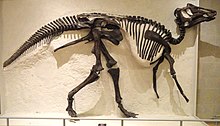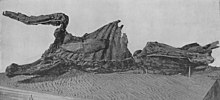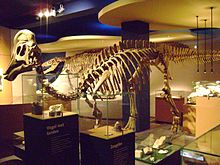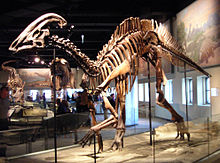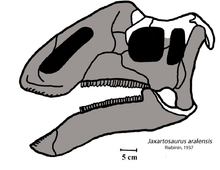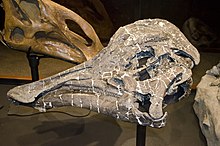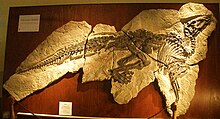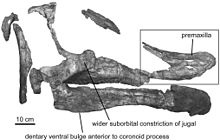
This timeline of hadrosaur research is a chronological listing of events in the history of paleontology focused on the hadrosauroids, a group of herbivorous ornithopod dinosaurs popularly known as the duck-billed dinosaurs. Scientific research on hadrosaurs began in the 1850s,[1] when Joseph Leidy described the genera Thespesius and Trachodon based on scrappy fossils discovered in the western United States. Just two years later he published a description of the much better-preserved remains of an animal from New Jersey that he named Hadrosaurus.[2]
The early 20th century saw such a boom in hadrosaur discoveries and research that paleontologists' knowledge of these dinosaurs "increased by virtually an order of magnitude" according to a 2004 review by Horner, Weishampel, and Forster. This period is known as the great North American Dinosaur rush because of the research and excavation efforts of paleontologists like Brown, Gilmore, Lambe, Parks, and the Sternbergs. Major discoveries included the variety of cranial ornamentation among hadrosaurs as scientist came to characterize uncrested, solid crested, and hollow crested species.[2] Notable new taxa included Saurolophus, Corythosaurus, Edmontosaurus, and Lambeosaurus.[3] In 1942 Richard Swann Lull and Wright published what Horner, Weishampel, and Forster characterized as the "first important synthesis of hadrosaurid anatomy and phylogeny".[2]
More recent discoveries include gigantic hadrosaurs like Shantungosaurus giganteus from China.[4] At 15 meters in length and nearly 16 metric tons in weight it is the largest known hadrosaur and is known from a nearly complete skeleton.[5]
Hadrosaur research has continued to remain active even into the new millennium. In 2000, Horner and others found that hatchling Maiasaura grew to adult body sizes at a rate more like a mammal's than a reptile. That same year, Case and others reported the discovery of hadrosaur bones in Vega Island, Antarctica. After decades of such dedicated research, hadrosaurs have become one of the best understood group of dinosaurs.[2]







